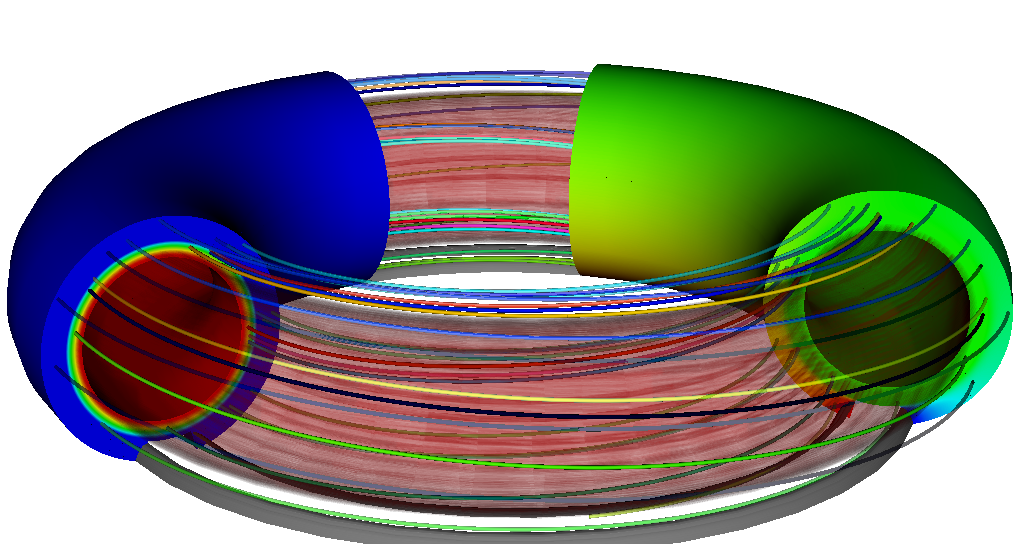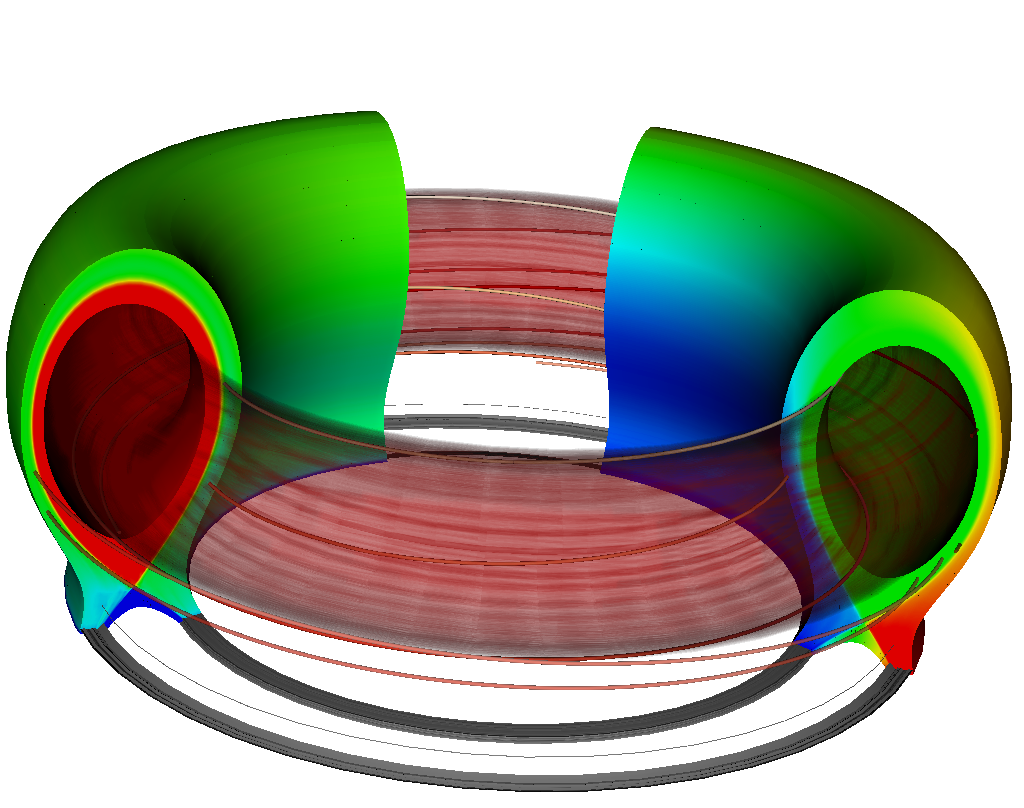Section: New Results
Simulations in plasma Physics
Fourier-spectral element approximation of a two fluid model of edge plasma
Participants : Richard Pasquetti, Sebastian Minjeaud.
We especially work on a two fluid physical model developed in close connection with Ph. Ghendrih (IRFM). It is based on the electrostatic assumption, i.e. the magnetic field is given (the magnetic field induced by the plasma itself is negligible), and on the hypothesis of electroneutrality (the density of ions and electrons are proportional). On the basis of the conservation equations of density, electron and ion velocities, electron and ion temperatures and electrical charges, a set of 10 non-linear coupled partial differential equations (PDE) can be set up. A high order Fourier-SEM (Spectral Element Method) code is currently developed. This Fourier-SEM code is now operational for the full set of PDEs in a 3D toroidal geometry. The torus section is discretized with quadrangular elements, within which the polynomial approximation degree is an input to the code. In time one uses an RK3 (third order Runge-Kutta) IMEX (Implicit-Explicit), so that the Lorentz terms are handled implicitly. The capability of this code to handle a strongly anisropic diffusion in a 3D toroidal geometry has already been tested. The Braginskii closure has been implemented. The Bohm boundary conditions at the plates are also considered. A parallel version of this code is currently developed. It remains to improve the robustness of our algorithms, i.e. to implement an efficient stabilization strategy. This could be based on the so-called spectral vanishing viscosity or entropy viscosity techniques. Up to our knowledge, this will be the first code that fully implements a two fluid ion-electron approximation (i.e. without using the drift velocity approximation), and the Braginskii closure of the governing equations.
Hydrodynamic model with strong Lorentz force
Participants : Audrey Bonnement, Hervé Guillard, Boniface Nkonga, Richard Pasquetti.
The thesis of A. Bonnement [1] was devoted to the development of a code based on the FluidBox/plaTo software of B. Nkonga and co-workers. It is based on a Finite volume / Finite element approach. This code is now operational in an axisymmetric geometry for a simplified PDE system in which the Lorentz force is approximated by a constant forcing field. Thus, the FluidBox/PlaTo code essentially solves the 3D axisymmetric Euler, Navier-Stokes or Braginskii PDEs to compute the ion density, momentum and energy. In the Braginskii system, the thermal diffusion and the kinematic viscosity are both non-linear and strongly anisotropic. A. Bonnement, who was co-directed by H. Guillard and R. Pasquetti, defended her thesis “Modélisation numérique bi-fluide du plasma de bord des tokamaks: application à ITER” in July 2012. A. Bonnement has provided a detailed description of the works carried out with the FluidBox/PlaTo code in her thesis manuscript. She has specially addressed one of the main difficulties related to simulations of tokamak plasmas, which is that the dynamic of the flows occurs in the vicinity of an equilibrium where the plasma pressure balances the Lorentz force. There are two ways to deal with this difficulty. The most common one in tokamak studies is to work with a set of governing equations such that this equilibrium is already contained in the formulation. This can be done by using formulations where the variables are indeed fluctuating departures from the equilibrium or by using special approximations as done in reduced MHD. The other way is purely numerical and consists to design a numerical method such that the equilibrium is an exact solution of the discrete equations. This has been the subject of the thesis of Audrey Bonnement in the framework of a finite volume method on non-structured meshes and where special Riemann solvers have been designed incorporating plasma equilibrium in the definition of the numerical fluxes. Combined with mesh refinement, this approach has been applied to some preliminary numerical experiments studying the effect of density perturbations (as a crude model of pellet injections) on the dynamics of the flow. At present, this approach is under evaluation to qualify its interest with respect to reduced MHD or formulations using a potential representation of the velocity field.
Finite volume methods in curvilinear system of coordinates
Participants : Hervé Guillard, Boniface Nkonga, Afeintou Sangam, Marco Bilanceri.
Finite volume methods are specialized techniques to approximate systems of conservation laws. The application of these methods to curvilinear systems of coordinate is however problematic because the space variation of the metric coefficients introduces artificial source terms. However it can be shown that whatever the curvilinear system used, a strong conservation form of the equations exists at the level of vector variables (but not at the level of the scalar components of the vectors in the curvilinear system due to the aforementioned space dependence of the metric coefficients). Based on this result, we have developed an original technique that uses an approximation of the vector form of the equation followed by local projection on the curvilinear system (here parallel to the poloidal magnetic field).
|
This method has been applied to the approximation of a reduced MHD model using a decomposition of the velocity field into a parallel component and a perpendicular one given by the electric drift. The method is general and can be applied to any type of geometry. Figure 2 shows for instance the steady state density and parallel velocity fields in the edge region of a limiter tokamak (left) and of a divertor tokamak (right). Bohm's boundary conditions have been applied to the limiter and divertor plates producing a supersonic outflow velocity field.
Mesh singularities and triangular elements
Participants : Boniface Nkonga, Marie Martin, José Costa.
C1-finite elements as used for instance in the Jorek code are associated to isoparametric cubic-Bezier representation over quadrangles in the poloidal plane and sine-cosine Fourier expansion in the toroidal direction. Mesh singularities are associated to the structure imposed by the cubic-Bezier representation over quadrangles. In the context of the ANR-ANEMOS and in collaborations with IRFM and the Galaad team (Inria Sophia Antipolis), a geometrical toolbox is under development to manage these singularities and improve the alignment with equilibrium flux surfaces. As an alternative, we are also developing a more flexible C1-element over triangles using either Reduced-quintic (Bell) or quadratic Powell-Sabin polynomials. Optimal order of accuracy is achieved with simple boundary conditions. Many cycles of the “current hole” instability has been accurately reproduced. Additional improvement, with isoparametric formulation, will hopefully achieve this optimality for curved boundaries and improve mesh alignment to flux surfaces. We have investigated the possibility to use cubic splines representation in the toroidal direction. Indeed, for pellet injection the local resolution needed in the toroidal direction requires a large number of Fourier modes. This resolution need is very local, adapted splines representation can be more efficient. This solution is under analysis and structuration. First application is expected at end of 2013 with a possible update of Jorek in 2014.
Mesh adaptation Methods
Participants : Hubert Alcin [Projet Tropics] , Alain Dervieux, Frédéric Alauzet [Projet Gamma, Inria-Rocquencourt] .
This activity results from a cooperation between Gamma, Tropics, Castor, and Lemma company. See details in Tropics and Gamma activity reports. Its concerns Castor's subject through the current applications of mesh adaptation to flows with interfaces and to Large Eddy Simulation. It is also planned to use mesh adaptation for simplified plasma models in the context of ANEMOS ANR project.
Stabilization for finite / spectral element
Participants : Boniface Nkonga, Marie Martin, Richard Pasquetti, Sebastian Minjeaud.
Formulation of Reduced MHD eliminates fast acoustic waves but material, slow acoustic and Alfven waves are included in this model. On the other hand, finite element approximation, when applied to hyperbolic systems (with finite speed waves) needs additional control of the effect of unresolved scales. We have developed and validated a Taylor Galerkin Stabilizations of order 2 and 3 (TG2-TG3) for reduced MHD. This global approach has been implemented in a simplified form, validated and updated in the latest versions of the Jorek code. Even if significant improvements have been observed with this stabilization where only material and Alfven waves subscales are stabilized, more robustness is expected by taking into account slow acoustic waves. Stabilization techniques well adapted to high order approximations, like the spectral vanishing viscosity method or the entropy viscosity technique, remain to be implemented in the Fourier-SEM code.
Validity of the Reduced MHD and extensions
Participants : Hervé Guillard, Boniface Nkonga, Afeintou Sangam.
The available reduced MHD model in Jorek uses a set of assumption that can be reasonable close to the equilibrium and during the linear grow of instabilities. In order to obtain accurate and robust simulations of the nonlinear instabilities saturations, careful analysis and derivation of the reduced MHD has been performed, more mathematical derivations are under progress under the asymptotic analysis framework. It turns out that some of the neglected terms can be of relative importance for the saturation process when MHD instabilities move the plasma far from equilibrium.
High performance parallel computing
Participants : Hervé Guillard, Boniface Nkonga, Sebastian Minjeaud.
Applications under concern in this project needs to manage large meshes ( to nodes) and solve many huge sparse nonlinear systems. This makes the use of domain partitioning techniques unavoidable. In addition, since different numerical methodologies are under studies and evaluations in this project, we need to develop a quite general setting allowing the use of different data structures (element-oriented for FE vs edge-oriented for FV) and the possibility to consider different domain overlapping to efficiently communicate between processors. For this we develop the PaMPA (Parallel Mesh Partitioning and Adaptation) software in collaboration with the Bacchus team (Inria, Bordeaux). PaMPA is based on the PT-Scotch graph partitioning tool and allows on the fly mesh redistribution. Up to now, PaMPA has been tested on 10000 processors with a mesh of 20M tetrahedrons. Integration of PaMPA as an external library to the codes developed in this project is under progress and early results are promising. Similarly, the Fourier-SEM code is currently parallelized.




